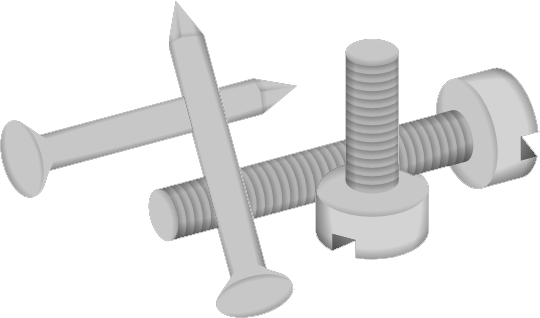Estimating bags and boxes
0
Overview
Using this Resource
Connecting to the Curriculum
Marking Student Responses
Working with Students
Further Resources
This task is about using a way of estimating that you have discussed with your teacher.

Nona wants a quick estimate of the total number of nails in some bags.
Make an estimate of about how many nails she has and explain how you did it in the box.
Make an estimate of about how many nails she has and explain how you did it in the box.
Task administration:
This task can be completed with pencil and paper or online.
This assessment activity is designed to be carried out with a group of students or a whole class. A suggested lesson sequence:
- Give the students the problem of estimating 27 × 23 to identify whether they use the rounding method.
- Discuss students' methods. Use the language of estimation in the Computational estimation concept map for each different method.
-
Introduce the rounding strategy in multiplication, i.e., round each number to the nearest 10, 100, etc. You may wish to write this example down as you discuss it.
Example: Estimate 27 × 23
27 rounds to 30 and 23 rounds to 20 so it's about 30 × 20 = 600 or
3 × 2 = 6 so its 600 because 10 × 10 = 100 - Students complete the sentence with the word "rounding", and then answer parts b) to e) to assess if they can apply it. Emphasise they are to use the rounding method only.
For more information about discussions see Classroom discourse (Mathematics)
Level:
4
Curriculum info:
Key Competencies:
Keywords:
Description of task:
Students estimate a multiplication problem, share their methods, discuss the rounding method, and then do more estimation problems using rounding.
Curriculum Links:
This resource can help to identify students' ability to apply multiplicative strategies flexibly to whole numbers when estimating multiplication problems.
Key competencies
This resource involves recording the strategies students use to estimate in multiplication problems. This relates to the Key Competency: Using language, symbols and text.
For more information see https://nzcurriculum.tki.org.nz/Key-competencies.
Learning Progression Frameworks
This resource can provide evidence of learning associated with within the Mathematics Learning Progressions Frameworks.
Read more about the Learning Progressions Frameworks.Answers/responses:
|
a) |
Makes a reasonable estimate close to 600 and gives a reasonable explanation of their method of estimating it. The rounding method would be: 600 because 30 × 20 = 600 or 3 × 2 = 6 so it's 600 |
|
b) |
400 or 320 |
|
c) |
900 |
|
d) |
4,800 |
|
e) |
80,000 or 84,000 |
NOTE:
- Other strategies are possible. If they don't use rounding methods, conference them to see if they can, even if they prefer other strategies.
- Students may use a combination of estimation and computation (i.e., computations that they cannot easily do in their heads and may need to write down, e.g., 2 165 × 40).
- More advanced students may adjust their estimates by making some form of final compensation. Give marks for this. It is possible to estimate and then compensate to get an exact answer, especially in c) (e.g., 8 × 37 8 × 40 = 320. This is 3 × 8 too big, so it's 296. This shows estimation thinking as long as it is all done mentally).
Diagnostic and formative information:
| Common error | Likely calculation | Likely misconception | |
|
a) b) c) d) e) |
27 × 23 8 × 37 34 × 28 258 × 129 38 × 2 165 |
621 296 952 33,282 82,270 |
Performs exact calculation rather than estimation. |
|
a) b) c) |
60 or 6,000 32 or 3,200 or 40 or 4,000 90 or 9,000 480 or 48,000 8,000 or 800,000 |
Result out by an order of magnitude (10 times too big or too small). Does not process the number of 0's in the estimate. |
Information on rounding for estimation
- Rounding takes a number to the nearest 10, 100, 1,000, etc.
- The research literature refers to estimation that changes numbers to more suitable ones as reformulation.
- Rounding with multiplication may give an underestimate or an overestimate of the true result. It gives a reasonably accurate estimate only if the amount of rounding up is proportionally about the same as the amount of rounding down. Recognising that one number being rounded down roughly balances the other one being rounded up is referred to as intermediate compensation.
- Final compensation (i.e., updating an initial estimate to a more accurate one) can be done with rounding in multiplication, but this is not always easy to do, as amounts may have to be both added on and subtracted off.
Prior knowledge needed
- A firm base of multiplicative basic facts.
- Good place value concepts.
- Understanding that estimation is a quick mental way of getting an answer close to the exact one.
- Ability to evaluate the order of magnitude of products (number of trailing 0's).
For similar ARB resources about rounding as an estimation method refer to: Estimating farm animals (rounding with addition); and Estimating people (rounding with subtraction).
For more information about computational estimation see the Computational estimation concept map.
Links with Numeracy Project
Using rounding as an estimation method with multiplication involves advanced additive/early multiplicative part-whole (Stage 6) knowledge and strategies (see The Number Framework, Book 1 (2004, p. 10 & 14). Wellington: Ministry of Education).
Using rounding as an estimation method with multiplication involves advanced additive/early multiplicative part-whole (Stage 6) knowledge and strategies (see The Number Framework, Book 1 (2004, p. 10 & 14). Wellington: Ministry of Education).

